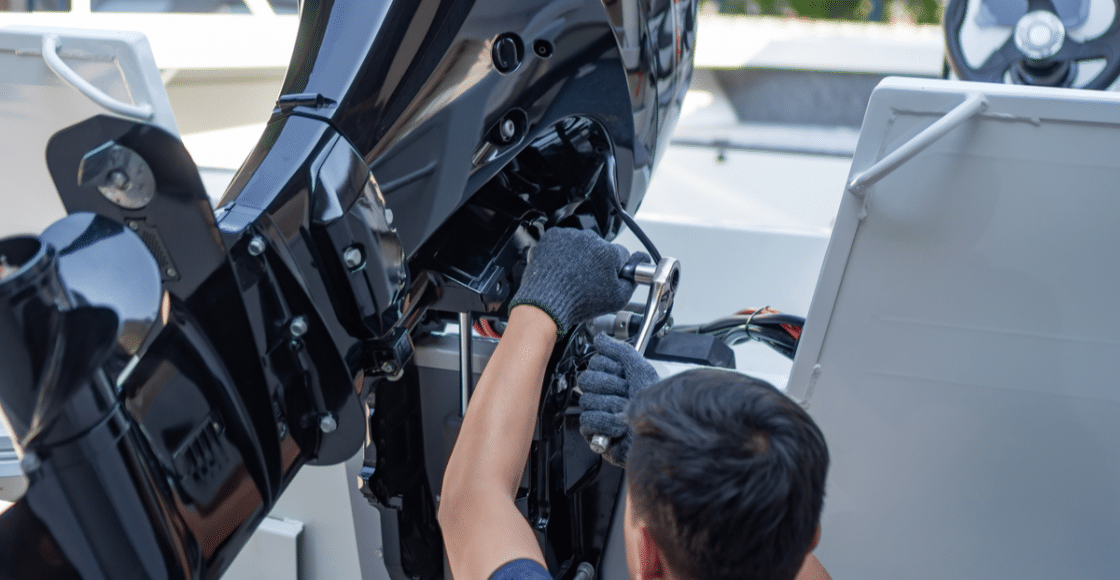What Are Bellows On A Boat?
Last Updated on January 14, 2022 by Boatsetter Team
If you hear the word bellows for the first time with boats, you might be confused. The image that might come to your head might be of a kind of device that blows air to keep a fire lit. This has no real connection to what is found on boats. Bellows on a boat are flexible gaskets that protect your boat’s engine from water. They feature a watertight seal to prevent rusting and other issues.
The only connection bellows on your boat have with the fire-managing devices most of us think of when we think of bellows is that they have an accordion shape to protect from moisture as well as other issues (such as debris) while also providing flexibility (this is provided through its accordion shape). Bellows are also used in folding cameras as well as expandable buses, not only on boats.
In a vehicle, your cooling system is always enclosed in the frame itself, while on boats, it is an open-water cooling system. This means boats dump the heat from the engine outside to keep the engine cool. It works great as a cooling system, but it does leave some components of your boat vulnerable to the damage that water can cause to them. This is where the bellows come in.
Now, let us move on to what kind of bellows are necessary for different kinds of boats, how to tell if yours are faulty, and how to fix them in the case that they are.
What Are The Different Types of Bellows?
Bellows are located on stern drives. They will not be found on inboards or outboards. These are found in the lower drive unit of your boat. These components also often come prepared with a pesticide that prevents wildlife from biting through the elements that are made of rubber. You should make sure to keep an eye on them, as they can cause you to have to replace the whole boat if they get too damaged.
How To Know Figure Out If Your Bellows Are Bad
There is a very easy way to figure out if there is something that is wrong with your bellows – if there is water in your cabin, then there is likely a crack somewhere in your boat (or perhaps a loose gasket or clamp). If there is a loud noise while driving, that might also be a sign of trouble. It can mean there are issues with the gimble bearing or the U-joint bellows.
If you notice any shifting issues, this likely means an issue with the gimble bearing or the U-joint bellows. If your boat overheats, it means that there is a problem with the exhaust bellow.
It can be extremely important to notice a problem with your bellows since you might need to replace the whole boat if the problem gets worse. This would be an incredibly expensive procedure that would take up quite a lot of your time and likely cause you some stress. So it is important to watch out for issues that can arise with regular boat maintenance.
How To Replace The Bellows On Your Boat
As much as repairing issues with your bellows and the components attached to them would not ever cost nearly as much as purchasing a whole new boat, repairs can still be quite expensive, depending on how many things might need to be replaced. This can also become a very time-consuming and arduous process. For this reason and more, it is of the utmost importance that you contact a mechanic that can help you in this process. You might have to remove the lower unit completely to get to the bellows, and that is likely something you should not try to do on your own.
You will need certain special tools to replace the bellows on your boat, many of which you might be able to find at your local auto parts store. You can often rent these out instead of having to buy them outright. Depending on where you live, this might be a little on the expensive side. You will also need adhesive and lubricant (these should be specifically for the make and model of the boat you own, so watch out for this).
If you find that one of your bellows is defective and needs replacing, it would be wise to replace all of them at once. These mechanisms take a very serious amount of damage, so if one of them has gone bad, then it is likely the others will do so soon as well. They can crack, the rubber can dry out, among other things. So as long as you have the lower unit off and are working on one already, you might as well take care of the others too. Although this can be a complicated process to understand, you should get through it in a short amount of time if you have the right help.
How To Remove the Drive On Your Bellows
The first step you need to do is to put the boat in the right gear. This depends on where the shift is located on your boat – if the shift on your boat is on the right, you should put the gear in reverse, and if it is not, you should put the gear forward. If your boat features two props, you should probably check your user manual before doing anything else.
The next step is to remove the prop. The drive on any boat is big enough to take at least two people and at most a hoist to remove it. You should be especially careful since doing this kind of procedure, you run the risk of injury, either from the drive itself or the unit.
Then you will want to release the trim cylinder. You should remain careful and not allow the skeg to hit the floor when the drive drops down. After this, you want to remove the bolts placed on the outdrive and take off the housing you find around the exhaust. Finally, you want to turn the unit to the port side to become easier to access.
The last step would be to use a hinge pin tool to access the shift cable (once the grounding screw and housing are free). This way, you can get to the bellows. You should not try to force the bellows out and use lubricant if you find it is necessary. Then, you should make sure to tie off the trim cylinder to a cleat so that they do not hang down and maybe break the hydraulic lines. Once you loosen the bolts that secure the drive, you can move on to the steps in the next few sections.
Replacing Exhaust Bellows
For the exhaust bellows, you will have to remove the clamps on both ends. You should cut the old bellows out first; then you can clean the forward mount. Put the clamp back in place in the adhesive and take a bellows expander tool to replace this part in the housing. Finally, you want to replace the front clamp and make sure that all of the screws face down.
Replacing U-Joint Bellows
This is similar to the one mentioned above, except you also have to check and replace both the gasket and the O-rings. You should also check the housing for rust and debris and clean it out if necessary. Getting new housing can be quite expensive so it is good to keep up with maintenance. You might also find that you have to replace the gimble bearing.
Replacing Shift Cable Bellows
Replacing the shift cable bellows is an easier process than the previous two are. These components are both smaller and easier to handle than the previous two, but the setup is essentially the same. You have to remove the clamps and clear the housing, and then replace the bellows. Make sure to do this correctly, or you might find yourself having more expensive problems later.
How To Avoid Future Problems With Your Bellows
Once you are familiar with the process, you can start incorporating it into your annual boat maintenance, so you can keep all your boat components healthy and accounted for. Be sure to replace other components (not just the bellows) if they look like they might need to be replaced. If you are not sure what issues to look for, ask a mechanic to teach you proper annual maintenance so you can tell early on if there is anything wrong.
Final Verdict
Bellows are a vital part of your boat. They keep it healthy and running smoothly, and they make sure you are safe out in the seas. It is important to study the proper maintenance of boats and their parts and regularly replace certain parts. This will ensure that your boat stays in tip-top shape for as long as possible.

Boatsetter empowers people to explore with confidence by showing them a world of possibility on the water. Rent a boat, list your boat, or become a Boatsetter captain today.










